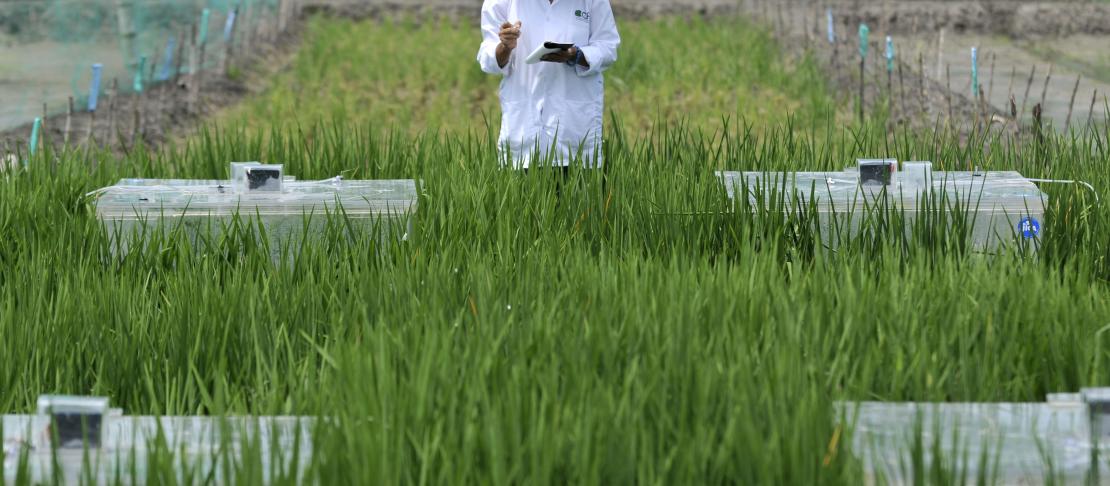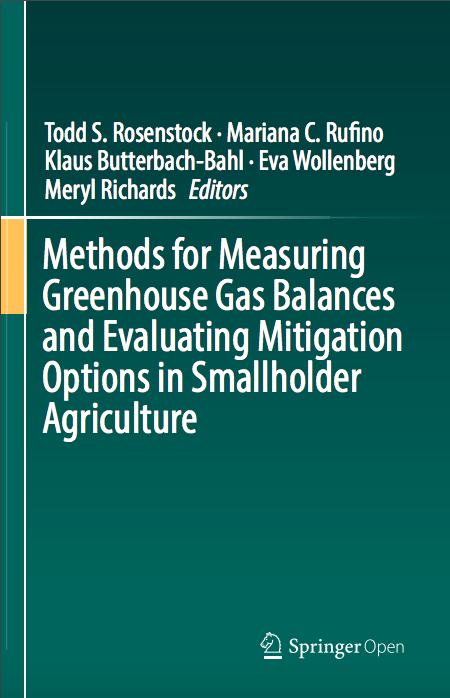Reliable and affordable methods for measurement of greenhouse gas emissions from agriculture now available

Book meets demand for advances in how to collect data on greenhouse gas sources and sinks from smalholder agriculture.
As countries shift from mitigation commitments to action in the 2016 climate change negotiations and beyond, many countries are unable to plan for emissions reductions in agriculture due to a lack of data.
Earlier this year, researchers found that data used to calculate emission factors and populate models do not accurately represent conditions on small farms in tropical developing countries because they largely come from research in temperate, developed countries.
The complex, smallholder agricultural systems in tropical, developing countries do not fit the same emissions profiles as temperate agricultural systems, which are often mono-cultural,” said Meryl Richards, a researcher from the CGIAR Research Program on Climate Change, Agriculture and Food Security (CCAFS) and the University of Vermont Gund Institute for Ecological Economics who co-edited the book.
"As countries begin implementing their climate change commitments, some are finding that they do not have reliable information about the mitigation potential of particular agricultural practices under local conditions. Getting that information often requires field measurement, which can be very expensive. This book is intended as a guide to conducting measurement in a way that provides the most information at the least cost.”
119 developing countries committed to mitigation in agriculture in the Paris Agreement but few countries shared details about how they will carry the pledges out. Agriculture (not including land use change) contributes an average of 35% of emissions in developing countries and 12% in developed countries.
“With the exception of a few crops and systems in tropical countries, there are few measured data for emissions from smallholder farms in developing countries,” Richards, said. “This book brings together the latest science in field measurements of agricultural greenhouse gas sources and sinks. Countries can use the methods and the data they produce to support improved emission factors for country inventories and to assess the mitigation impacts of practice changes and projects.”
The book, Methods for Measuring Greenhouse Gas Balances and Evaluating Mitigation Options in Smallholder Agriculture, explains how to:
- Design a measurement program;
- Quantify stocks, stock changes and fluxes of the major GHG sources and sinks including: land use and land cover change, greenhouse gas emissions from soils, methane emissions due to enteric fermentation in ruminants, biomass carbon, and soil carbon stocks; and
- Use field measurements to estimate mitigation potential at larger scales, and assess trade-offs between climate change and development objectives.
Recognizing that cost of research has often been an impediment for some countries, authors provide guidance on how to choose from available methods, given users’ objectives, resources, and capacities.
Authors expect that national agricultural research centers, compilers of national greenhouse gas inventories, policy makers, agricultural development practitioners, universities and the private sector will find the guidelines useful to fulfill reporting requirements to the United Nations Framework Convention on Climate Change and to identify and implement low emissions development practices that will fulfill mitigation targets outlined in the Paris Agreement. “As soon as the measurement data is collected, countries will be ready to use it,” Richards added.
Resources
We will be publishing user guides and videos to accompany some of the chapters. Please see the video below summarizing the Quantifying Greenhouse Gas Emissions from Managed and Natural Soils chapter or see the presentation here.
Further reading
- Limits of agricultural greenhouse gas calculators to predict soil N2O and CH4 fluxes in tropical agriculture
- Agriculture’s prominence in the INDCs
- Agriculture’s contribution to national emissions
Download the book:
Rosenstock TS, Rufino MC, Butterbach-Bahl K, Wollenberg E, Richards MB (eds). 2016. Methods for Measuring Greenhouse Gas Balances and Evaluating Mitigation Options in Smallholder Agriculture. New York: Springer. Available free at: http://dx.doi.org/10.1007/978-3-319-29794-1
Editors
- Todd S. Rosenstock, World Agroforestry Center (ICRAF)
- Mariana C. Rufino, Center for International Forestry Research (CIFOR), Lancaster University
- Klaus Butterbach-Bahl, International Livestock Research Institute (ILRI), Karlsruhe Institute of Technology (KIT)
- Eva Wollenberg, Gund Institute for Ecological Economics, University of Vermont, CGIAR Research Program on Climate Change, Agriculture, and Food Security (CCAFS)
- Meryl Richards, Gund Institute for Ecological Economics, University of Vermont, CGIAR Research Program on Climate Change, Agriculture, and Food Security (CCAFS)
Authors
Chapter 1: Introduction to the SAMPLES approach
- Todd S. Rosenstock, World Agroforestry Centre (ICRAF)
- Bjoern Ole Sander, International Rice Research Institute (IRRI)
- Klaus Butterbach-Bahl, International Livestock Research Institute (ILRI), Karlsruhe Institute of Technology (KIT)
- Mariana C. Rufino, International Centre for Forestry Research (CIFOR), Lancaster University
- Jonathan Hickman, Earth Institute at Columbia University
- Clare Stirling, International Maize and Wheat Improvement Centre (CIMMYT)
- Meryl Richards, Gund Institute for Ecological Economics, University of Vermont, CGIAR Research Program on Climate Change, Agriculture, and Food Security (CCAFS)
Chapter 2: Targeting landscapes to identify mitigation options in smallholder agriculture
- Mariana C. Rufino, International Centre for Forestry Research (CIFOR), Lancaster University
- Clement Atzberger, University of Natural Resources (BOKU)
- Germán Baldi, Instituto de Matemática Aplicada San Luis, Universidad Nacional de San Luis and Consejo Nacional de Ciencia y Tecnología (CONICET)
- Klaus Butterbach-Bahl, International Livestock Research Institute (ILRI), Karlsruhe Institute of Technology (KIT)
- Todd Rosenstock, World Agroforestry Centre (ICRAF)
- David Stern, Maseno University
Chapter 3: Determining greenhouse gas emissions and removals associated with land use and land cover change
- Sean P. Kearney, University of British Columbia
- Sean M. Smukler, University of British Columbia
Chapter 4: Quantifying greenhouse gas emissions from managed and natural soils
- Klaus Butterbach-Bahl, International Livestock Research Institute (ILRI), Karlsruhe Institute of Technology (KIT)
- Bjoern Ole Sander, International Rice Research Institute (IRRI)
- David Pelster, International Livestock Research Institute (ILRI)
- Eugenio Díaz-Pinés, Karlsruhe Institute of Technology (KIT)
Chapter 5: A Comparison of methodologies for measuring methane emissions from ruminants
- J.P. Goopy, International Livestock Research Institute (ILRI)
- C. Chang, Wageningen University
- N. Tomkins, Commonwealth Scientific and Industrial Research Organisation (CSIRO)
Chapter 6: Quantifying tree biomass carbon stocks and fluxes in agricultural landscapes
- Shem Kuyah, World Agroforestry Centre (ICRAF), Jomo Kenyatta University of Agriculture and Technology (JKUAT)
- Cheikh Mbow, World Agroforestry Centre (ICRAF)
- Gudeta W Sileshi
- Meine van Noordwijk, World Agroforestry Centre (ICRAF)
- Katherine L. Tully, Columbia University
- Todd S Rosenstock, World Agroforestry Centre (ICRAF)
Chapter 7: Methods for smallholder quantification of soil carbon stocks and stock changes
- Gustavo Saiz, Karlsruhe Institute of Technology (KIT)
- Alain Albrecht, Institut de recherché pour le développement (IRD)
Chapter 8: Yield estimation of food and non-food crops in smallholder production systems
- Tek B Sapkota, International Maize and Wheat Improvement Centre (CIMMYT)
- ML Jat, International Maize and Wheat Improvement Centre (CIMMYT)
- RK Jat, International Maize and Wheat Improvement Centre (CIMMYT), Borlaug Institute of South Asia
- P. Kapoor, International Maize and Wheat Improvement Centre (CIMMYT)
- Clare Stirling, International Maize and Wheat Improvement Centre (CIMMYT)
Chapter 9: Scaling point/plot measurements of greenhouse gas fluxes, balances and intensities to whole-farms and landscapes
- Todd S. Rosenstock, World Agroforestry Centre (ICRAF)
- Mariana C. Rufino, International Centre for Forestry Research (CIFOR), Lancaster University
- Ngonidzashe Chirinda, International Center for Tropical Agriuculture (CIAT)
- Lenny van Bussel, Wageningen University and Research Centre
- Pytrik Reidsma, Wageningen University and Research Centre
- Klaus Butterbach-Bahl, International Livestock Research Institute (ILRI), Karlsruhe Institute of Technology (KIT)
Chapter 10: Methods for environment–productivity trade-off analysis in agricultural systems
- Mark T van Wijk, Wageningen University and Research Centre
- CJ Klapwijk, Wageningen University and Research Centre, International Institute of Tropical Agriculture (IITA)
- Todd S. Rosenstock, World Agroforestry Centre (ICRAF)
- Piet JA van Asten, International Institute of Tropical Agriculture (IITA)
- Philip K Thornton, International Livestock Research Institute (ILRI), CGIAR Research Program on Climate Change, Agriculture, and Food Security (CCAFS)
- Ken E Giller, Wageningen University and Research Centre
The CGIAR Research Program on Climate Change, Agriculture and Food Security (CCAFS) brings together the world’s best researchers in agricultural science, development research, climate science and Earth System science, to identify and address the most important interactions, synergies and trade-offs between climate change, agriculture and food security. The University of Vermont hosts research focusing on low emissions agriculture. Research is carried out with support from CGIAR Fund Donors and through bilateral funding agreements. For details please visit https://ccafs.cgiar.org/donors.
Julianna White is the program manager for CCAFS low emission agriculture research.




